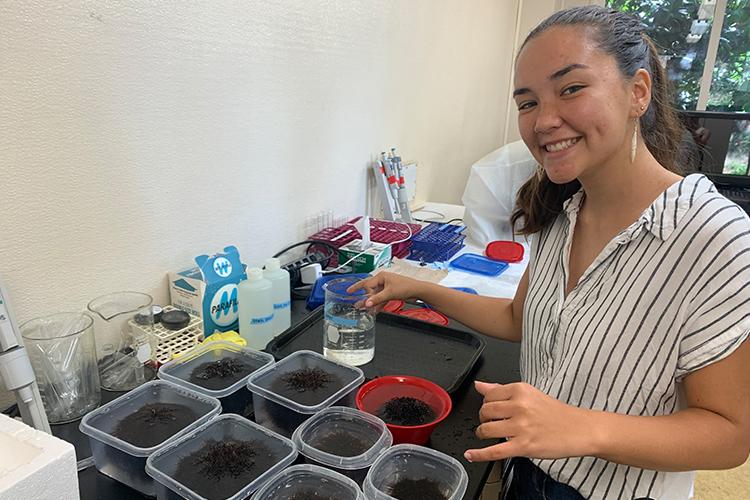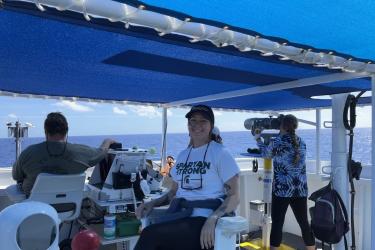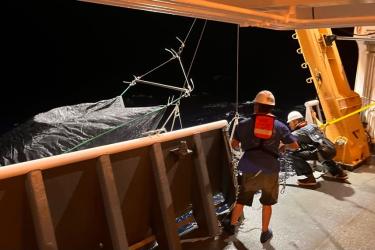Aloha, my name is Mariko Quinn, and I was an intern with the He‘eia National Estuarine Research Reserve during the 2021 Hollings Preparation Program. During my time in the program, I expanded my experience as a researcher and built important connections for my future.
Introduction to Research
My journey into the Hollings Prep Program began when I participated in the Hawaiʻi State Science Fair as a senior in high school. Growing up on the water in Kāneʻohe, O‘ahu, I’ve always been interested in the marine environment—the science fair allowed me to further explore these interests. Through the science fair, I engaged with NOAA scientists who judged my project and gave me advice on how to further my research experience. One of the scientists suggested that I participate in the Hollings Prep Program as an undergraduate, as it would allow me to pursue different avenues in marine science and learn about the careers available within the field.
Working With the Heʻeia National Estuarine Research Reserve
As a Hollings Prep Program intern, I worked with the Heʻeia National Estuarine Research Reserve. Over the summer, my partner, Hollings Intern Sam Koeck, and I worked on a project using collector sea urchins (Tripneustes gratilla) to assess the water quality around Moku o Loʻe (Coconut Island) and throughout the Heʻeia NERR area in Kāneʻohe Bay. We used a modified version of the Whole Effluent Toxicity Test Protocol, developed by the U.S. Environmental Protection Agency. This protocol allows us to determine if sea urchins can effectively reproduce in different areas. If a water sample yields low fertilization, this indicates poor water quality. We collected and assessed water quality samples from around the Heʻeia NERR and compared our results with physical water quality parameters.
Working with the Heʻeia NERR also allowed me to further connect with the area I grew up in through our weekly laulima days (group workdays). During our laulima days, we worked with nonprofit organizations Pae Pae O Heʻeia and Kāko‘o ‘Ōiwi, which are both partners of the Heʻeia NERR and are working to restore the wetland areas of Heʻeia. I also connected with other interns, students, and scientists working with the Heʻeia NERR while helping to restore the environment in my home communities.
Connecting with People Across the Pacific
The Hollings Prep Program internship incorporated weekly workshops and webinars that allowed us to connect with other Hollings interns and NOAA researchers throughout the organization. These activities were incredible opportunities to network and become more familiar with the different branches and jobs within NOAA.
Through this internship, I gained experience as an independent researcher in a lab setting, allowing me to be more comfortable with both lab and fieldwork. In particular, I learned a lot about experimental design and decision making. Sam and I spent significant time learning how to adjust our experiment to answer the proper questions and developing the most effective methods to do that. This taught me important aspects of experimental design that I will be able to translate into future research I conduct. Furthermore, I learned a lot about the Hollings Scholarship Program itself and how I might be able to build upon my Hollings Prep Program experiences as a Hollings scholar.
Several months after participating in the program, I presented at the NOAA Science Fair Student and Teacher Workshop. This presentation allowed me to connect with students and discuss how participating in the Hawaiʻi State Science Fair impacted me. Leaning on my experiences, I also provided guidance to some students about forming their projects and beginning their research journey.
Overall, the Hollings Prep Program allowed me to grow as a scientist, student, and community member. It was an incredible summer of connecting with many new people and the area in which I grew up.
Meet the Blogger
Mariko Quinn was a summer 2021 intern with the Hollings Prep Program. She is from Kāneʻohe, Hawaiʻi and graduated from Castle High School in 2020. Currently, she is a sophomore at the University of Hawaiʻi at Mānoa majoring in global environmental science and minoring in political science. She plans to pursue a career in marine science and environmental policy.





